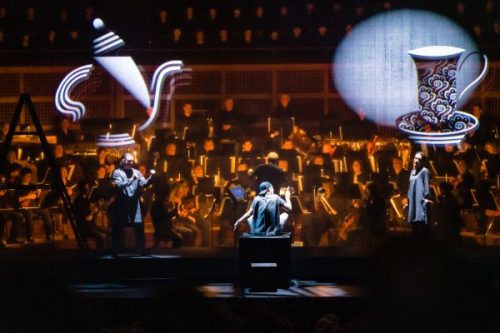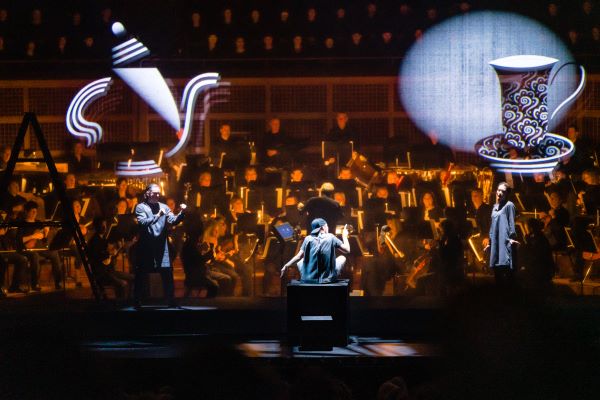 United States Debussy, Fauré, Ravel: Soloists, Young Women’s Chorus of San Francisco (director: Susan McMane), San Francisco Boys Chorus (director: Ian Robertson), San Francisco Symphony Chorus (director: Ragnar Bohlin), San Francisco Symphony / Martyn Brabbins (conductor), Davies Symphony Hall, San Francisco. 27.6.2019. (HS)
United States Debussy, Fauré, Ravel: Soloists, Young Women’s Chorus of San Francisco (director: Susan McMane), San Francisco Boys Chorus (director: Ian Robertson), San Francisco Symphony Chorus (director: Ragnar Bohlin), San Francisco Symphony / Martyn Brabbins (conductor), Davies Symphony Hall, San Francisco. 27.6.2019. (HS)

Debussy – Selections from Children’s Corner and La plus que lente
Fauré – Piano Quartet No.1 in C minor, Allegro molto
Ravel – ‘The Enchanted Garden’ from Mother Goose
Ravel – L’Enfant et les sortilèges
Production:
Concept and Video — Grégoire Pont
Stage Director — James Bonas
Stage and Costume Design — Thibault Vancraenenboeck
Lighting Design — Christophe Chaupin
Cast:
The Child — Isabel Leonard
The Fire, The Princess, The Nightingale — Anna Christy
The Bat, A Country Lass — Nikki Einfeld
The Bergère, The Screech-owl — Marnie Breckenridge
A Herdsman, The Chinese Cup, The White Cat — Ginger Costa Jackson
Mama, The Dragonfly, The Squirrel — Jennifer Johnson-Cano
The Little Old Man, The Tree Frog, The Teapot — Ben Jones
The Comtoise Clock, The Black Cat — Kelly Markgraf
The Armchair, A Tree — Michael Todd Simpson
There is magic in Ravel’s treasure of a one-act opera, L’Enfant et les sortilèges. The title, which roughly translates to ‘the child and magic spells’, could also refer to Ravel’s score and the libretto by the French author Colette, who conjure an utterly captivating world. In its first of three performances, the San Francisco Symphony’s final 2018-19 subscription offering found ways to enhance that world even further.

A superbly cast array of singers – led by mezzo-soprano Isabel Leonard in the title role – inhabited a space defined by Grégoire Pont’s ingenious projections onto two scrims, one behind the other, separating the orchestra from the singers at the front of the stage. The animation, timed with images that surrounded and defined characters, seemed to respond to the music, the words, and the acting.
First seen at Opéra National de Lyons in 2016, this staging adapted perfectly to the much larger Davies Symphony Hall. During the brief prelude, a dancing ball of light etched out the title in random swaths. A wagging pointing hand enhanced Maman’s admonishment of the misbehaving Child. The character Fire burst into colorful projected flame, and a whole pond full of projected frogs and tadpoles surrounded the audience as the amphibians climbed the walls of Davies Hall. Mathematics, represented by a pointy-hatted man on stilts, filled the scrim with nonsense equations until the projections all collapsed onto the stage.
Clever as all those touches were, the most impressive magic was in Ravel’s score. Martyn Brabbins, music director of English National Opera, had the orchestra bubbling with French flair and with on-point pacing, in sync with a cast that remained nimble vocally and physically.
The story traces a six-year-old boy’s day in a Normandy mansion with a woodsy garden. Refusing to do his homework, he trashes his room, and then the destroyed furniture, toys and wallpaper come to life to chastise him. Finally, an act of kindness leads to universal forgiveness, bathed in the warmth of some of Ravel’s most touching orchestral pages.
Clad in a baseball cap (its bill turned around to hide her long hair), boys’ shorts and a loose-fitting shirt to camouflage her figure, Leonard manifested the jerky, impetuous physicality of a misbehaving boy. The voice, however, was pure mezzo silk, punctuated by the occasional (intentional) squawk. She was the riveting center of this production, even in the long sections when she didn’t sing.
With the projections replacing traditional costumes, the other singers — each singing multiple roles — only needed to wear black, or don the occasional translucent flowing garment to show the projections. The cast climbed onto boxes or ladders to provide depth to the stage images, and they all sang with accuracy and color.
Most impressive was soprano Anna Christy, who displayed vivid coloratura as the Nightingale (aided and abetted by Catherine Payne’s flashy piccolo work) and a sweet lyric tone as The Princess. Mezzo-soprano Ginger Costa Jackson created a sympathetic Herdsman torn from the wallpaper, a saucy Chinese Cup, and drew laughs as a miaou-ing White Cat. Jennifer Johnson-Cano, also a mezzo, lent gravitas to Mama, and gave the Dragonfly and the Squirrel individual vocal personalities.
On the male side, baritone Kelly Markgraf was the standout as the dinging Clock and the mischievous Black Cat. Bass-baritone Michael Todd Simpson lent solidity to the Armchair and the wounded Tree (the latter in a subtly colored projection of the garden).
The original idea was to pair this 45-minute opera with Britten’s Noye’s Fludde, about the same length. Both were to be conducted by the orchestra’s music director, Michael Tilson Thomas, but he withdrew to undergo a heart procedure (which was done successfully last week). The Britten was jettisoned in favor of a an apéritif in the first half, a folio of short French chamber works.
In a sort of salon setting, pianist John Wilson opened with three pieces from Debussy’s Children’s Corner and La plus que lente, a nod to Budapest’s Gypsy ensembles for which seven members of the orchestra joined in enthusiastically. Costa-Jackson, accompanied by pianist Peter Grunberg, sang a sincere ‘Noël des enfants qui n’ont plus de maisons’, and its message of children deprived of their homes by war resonated with today’s pertinent border and immigration issues.
Members of the orchestra romped through the Allegro molto from Fauré’s Piano Quartet No.1 in C minor — Sayaka Tanikawa on piano — and Wilson and Grunberg prefaced the opera with more Ravel, a four-hand flourish in ‘The Enchanted Garden’ from Mother Goose.
It was all likeable, even admirable, but mostly forgettable. The opera, however, won’t disappear from memory soon.
Harvey Steiman
